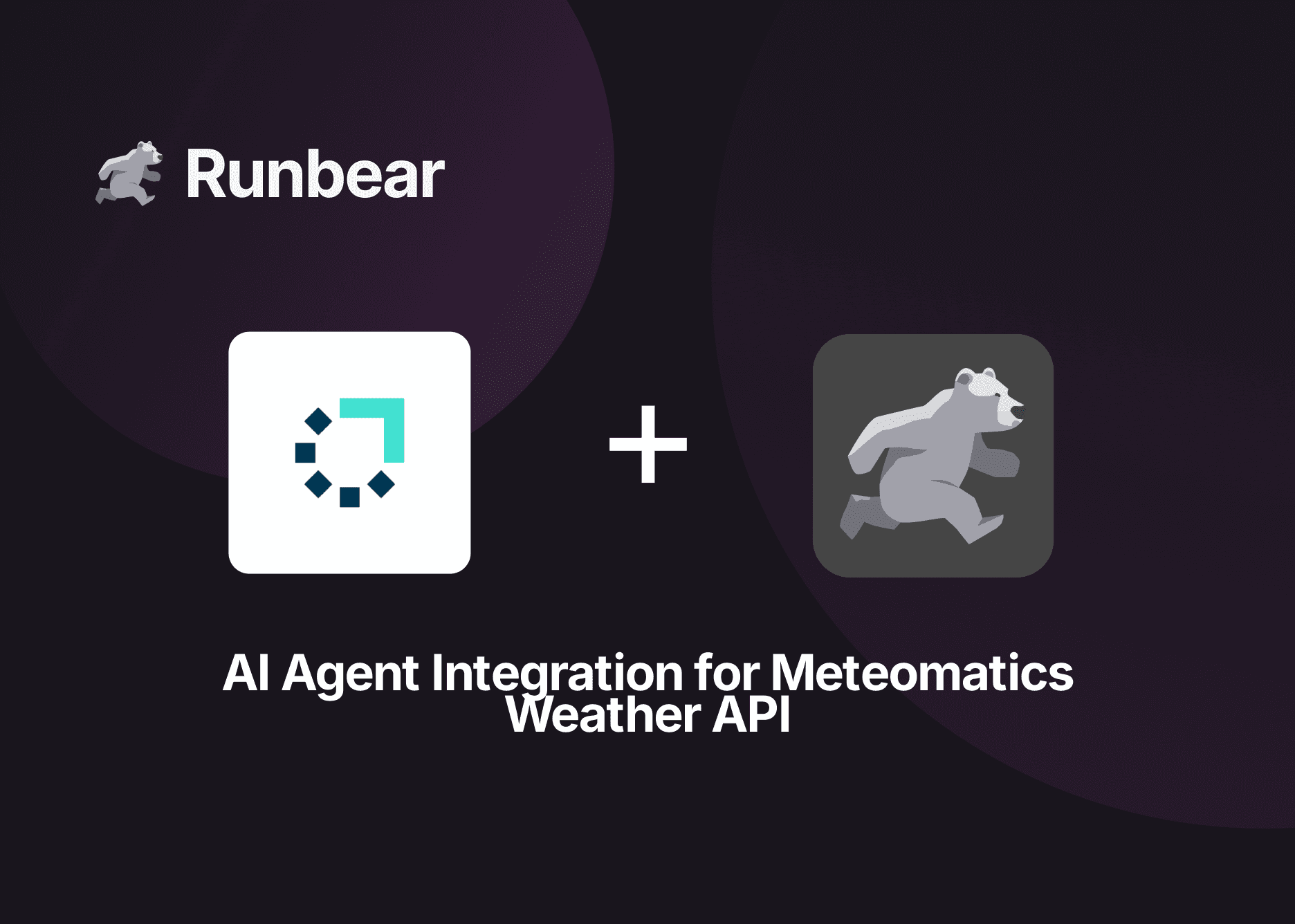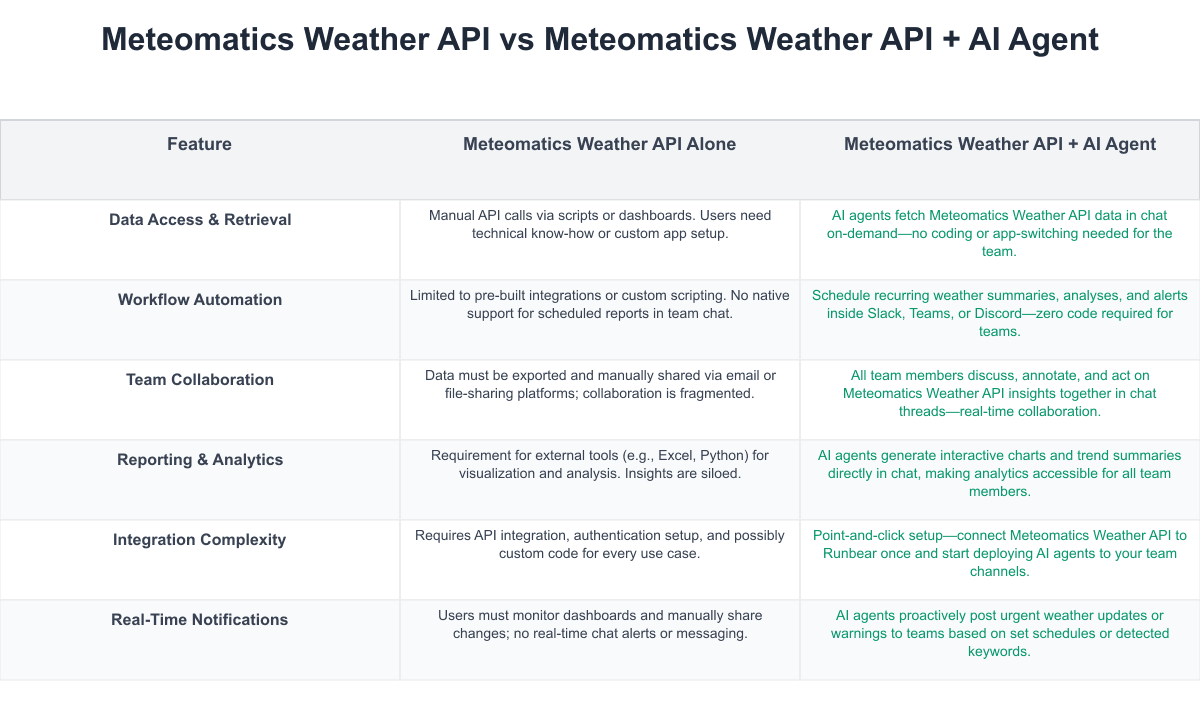Team AI Agent Integration with Meteomatics Weather API
Schedule daily Meteomatics Weather API summaries delivered by an AI agent directly to your team's Slack channels. Enhance your Meteomatics Weather API workflows with AI-powered automation in Slack, Teams, and Discord.

The weather isn’t just small talk—it’s pivotal business intelligence. For organizations using the Meteomatics Weather API, accessing granular weather insights is crucial for planning, safety, and operational efficiency. However, these powerful datasets can become even more actionable when combined with Runbear’s AI agent platform—enabling teams to receive, share, and act on weather intelligence right within their team chat, automating workflows and fostering real-time collaboration.
About Meteomatics Weather API
Meteomatics Weather API is a leading weather and climate data platform trusted by industries worldwide for its high-resolution, global forecasts, historical records, and climate projections. Featuring more than 1,800 weather parameters—ranging from temperature and precipitation to wind speed, solar radiation, and climatic trends—the API is designed for reliability and precision. Meteomatics supports robust integrations and is used by energy companies, logistics operators, aviation, agriculture, and any organization that relies on accurate weather intelligence. Its powerful RESTful API and frequent updates make it suitable both for real-time applications and in-depth analytics, all tailored for modern, data-driven teams seeking a competitive edge through weather awareness. For details on how the API fits enterprise workflows, visit the Meteomatics Weather API page.
Use Cases in Practice
When you connect the Meteomatics Weather API to an AI agent inside Slack, Teams, or Discord with Runbear, weather data shifts from isolated dashboards into the very heart of your team's workspace. Imagine your operations or planning teams receiving daily weather briefings before their standups, supply chain teams instantly querying for hyper-local forecasts on-demand, or your safety committee getting real-time alerts if severe weather is predicted. With keyword triggers, every mention of 'storm' or 'forecast' prompts the AI agent to surface up-to-the-minute Meteomatics Weather API insights. And when cross-functional teams need to analyze trends—such as comparing historical data to forecasted conditions—they can do so collaboratively, using AI agent-generated charts and summaries right in the chat channel. This fast-track to weather data streamlines decision-making, improves response time, and ensures everyone stays on the same (weather) page. For further inspiration on how AI automation can simplify business analytics, check out Simplify Your Business Analytics and learn how teams are already slashing manual work with Runbear.
Meteomatics Weather API vs Meteomatics Weather API + AI Agent: Key Differences

Integrating Meteomatics Weather API with Runbear transforms manual data retrieval into conversational, AI-powered team workflows. Instead of relying on individual searches and basic export tools, AI agents make weather intelligence instantly available, collaborative, and actionable where teams already work. This shift means less context-switching, more automation, and a smoother path from weather data to business decisions.
Implementation Considerations
Teams using the Meteomatics Weather API often face steep setup requirements, needing technical talent for integration and ongoing maintenance. Data retrieval typically demands scripting, and disseminating insights across teams can become fragmented—relying on spreadsheets, emails, or manual exports. Training is required to onboard non-technical users, while maintaining secure API keys and managing access adds operational risk. Change management becomes necessary as business units seek more self-serve access or automate workflows. With Runbear, teams can bypass much of this friction: setup becomes a simple connection; everyone can request or schedule data using natural language; and the AI agent automates compliance, visibility, and knowledge sharing. However, organizations should still plan for permission management, define clear usage policies for weather data, and provide teams with basic onboarding to maximize the integration's value.
Get Started Today
The future of weather intelligence is collaborative, conversational, and automated. By combining the comprehensive data of Meteomatics Weather API with the flexibility of Runbear's AI agent platform, teams unlock faster, smarter decisions—right where they work. Whether it’s daily planning, critical alerts, or insightful analytics, AI agent-powered workflows deliver real business value. Ready to bring weather insights into your chat channels? Start a free trial of Runbear, connect Meteomatics Weather API, and see how your team can work weather-smart today.